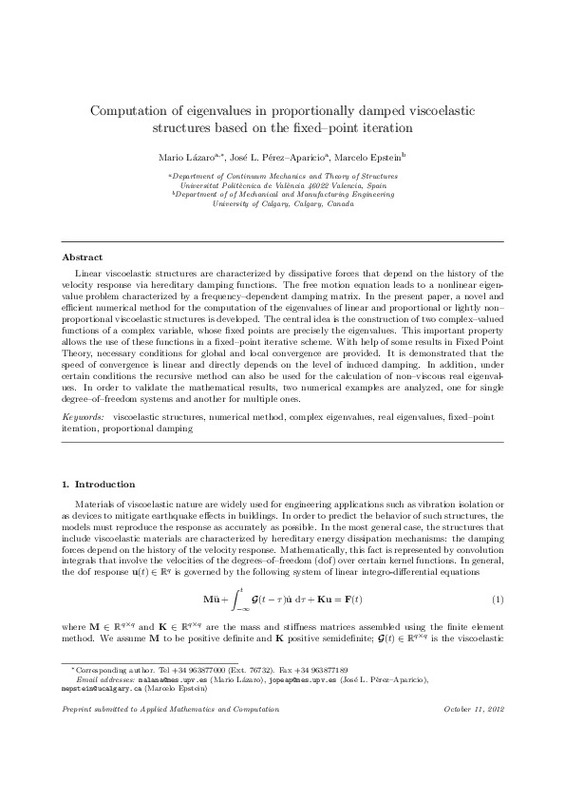JavaScript is disabled for your browser. Some features of this site may not work without it.
Buscar en RiuNet
Listar
Mi cuenta
Estadísticas
Ayuda RiuNet
Admin. UPV
Computation of eigenvalues in proportionally damped viscoelastic structures based on the fixed-point iteration
Mostrar el registro sencillo del ítem
Ficheros en el ítem
| dc.contributor.author | Lázaro Navarro, Mario
|
es_ES |
| dc.contributor.author | Pérez Aparicio, José Luis
|
es_ES |
| dc.contributor.author | Epstein, M.
|
es_ES |
| dc.date.accessioned | 2015-11-17T13:19:56Z | |
| dc.date.available | 2015-11-17T13:19:56Z | |
| dc.date.issued | 2012-12-15 | |
| dc.identifier.issn | 0096-3003 | |
| dc.identifier.uri | http://hdl.handle.net/10251/57627 | |
| dc.description.abstract | Linear viscoelastic structures are characterized by dissipative forces that depend on the history of the velocity response via hereditary damping functions. The free motion equation leads to a nonlinear eigenvalue problem characterized by a frequency-dependent damping matrix. In the present paper, a novel and efficient numerical method for the computation of the eigenvalues of linear and proportional or lightly non-proportional viscoelastic structures is developed. The central idea is the construction of two complex-valued functions of a complex variable, whose fixed points are precisely the eigenvalues. This important property allows the use of these functions in a fixed-point iterative scheme. With help of some results in fixed point theory, necessary conditions for global and local convergence are provided. It is demonstrated that the speed of convergence is linear and directly depends on the level of induced damping. In addition, under certain conditions the recursive method can also be used for the calculation of non-viscous real eigenvalues. In order to validate the mathematical results, two numerical examples are analyzed, one for single degree-of-freedom systems and another for multiple ones. | es_ES |
| dc.description.sponsorship | The authors gratefully acknowledge the support of the Polytechnic University of Valencia under programs PAID 02-11-1828 and 05-10-2674 and of the National Science and Research Council of Canada. | en_EN |
| dc.language | Inglés | es_ES |
| dc.publisher | Elsevier | es_ES |
| dc.relation.ispartof | Applied Mathematics and Computation | es_ES |
| dc.rights | Reserva de todos los derechos | es_ES |
| dc.subject | Viscoelastic structures | es_ES |
| dc.subject | Numerical method | es_ES |
| dc.subject | Complex eigenvalues | es_ES |
| dc.subject | Real eigenvalues | es_ES |
| dc.subject | Fixed-point iteration | es_ES |
| dc.subject | Proportional damping | es_ES |
| dc.subject.classification | MECANICA DE LOS MEDIOS CONTINUOS Y TEORIA DE ESTRUCTURAS | es_ES |
| dc.title | Computation of eigenvalues in proportionally damped viscoelastic structures based on the fixed-point iteration | es_ES |
| dc.type | Artículo | es_ES |
| dc.identifier.doi | 10.1016/j.amc.2012.09.026 | |
| dc.relation.projectID | info:eu-repo/grantAgreement/UPV//PAID-02-11-1828/ | es_ES |
| dc.relation.projectID | info:eu-repo/grantAgreement/UPV//PAID-05-10-2674/ | es_ES |
| dc.rights.accessRights | Abierto | es_ES |
| dc.contributor.affiliation | Universitat Politècnica de València. Departamento de Mecánica de los Medios Continuos y Teoría de Estructuras - Departament de Mecànica dels Medis Continus i Teoria d'Estructures | es_ES |
| dc.description.bibliographicCitation | Lázaro Navarro, M.; Pérez Aparicio, JL.; Epstein, M. (2012). Computation of eigenvalues in proportionally damped viscoelastic structures based on the fixed-point iteration. Applied Mathematics and Computation. 219(8):3511-3529. https://doi.org/10.1016/j.amc.2012.09.026 | es_ES |
| dc.description.accrualMethod | S | es_ES |
| dc.relation.publisherversion | http://dx.doi.org/10.1016/j.amc.2012.09.026 | es_ES |
| dc.description.upvformatpinicio | 3511 | es_ES |
| dc.description.upvformatpfin | 3529 | es_ES |
| dc.type.version | info:eu-repo/semantics/publishedVersion | es_ES |
| dc.description.volume | 219 | es_ES |
| dc.description.issue | 8 | es_ES |
| dc.relation.senia | 230460 | es_ES |
| dc.contributor.funder | Universitat Politècnica de València | es_ES |






![[Cerrado]](/themes/UPV/images/candado.png)


